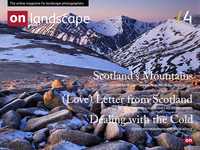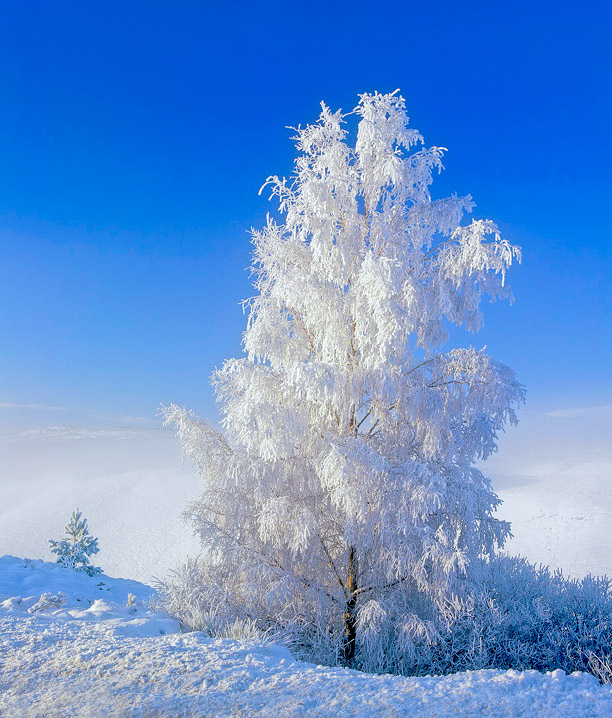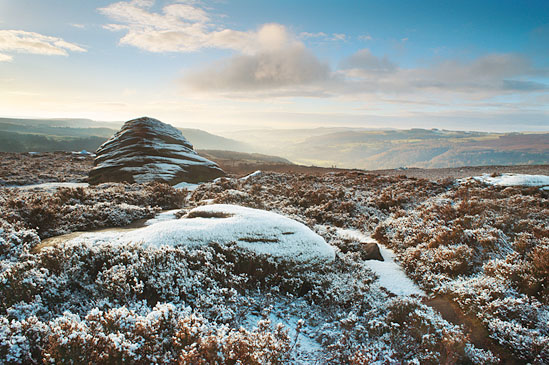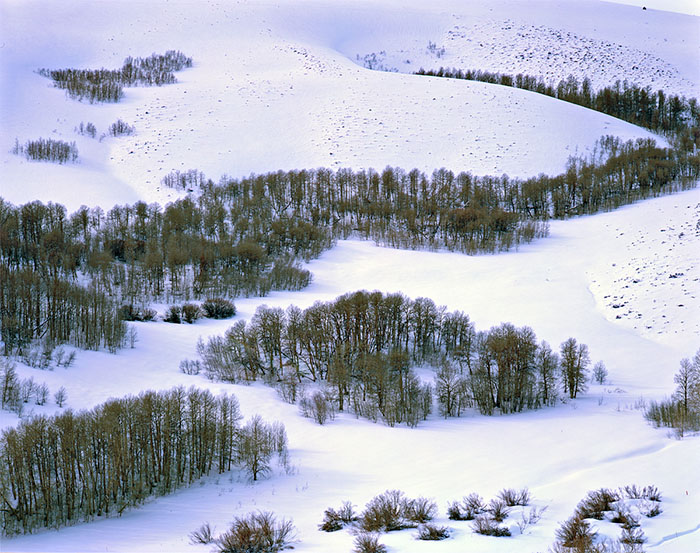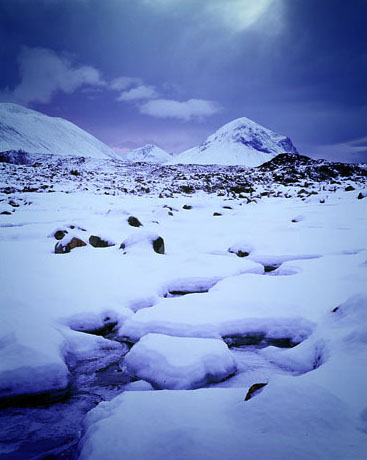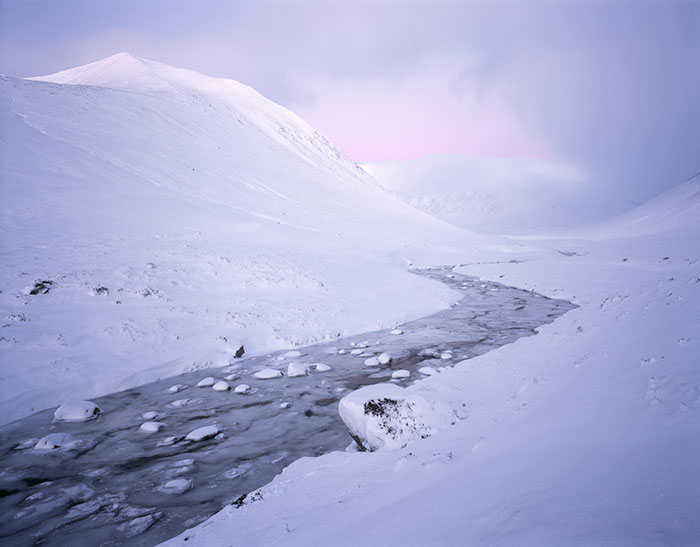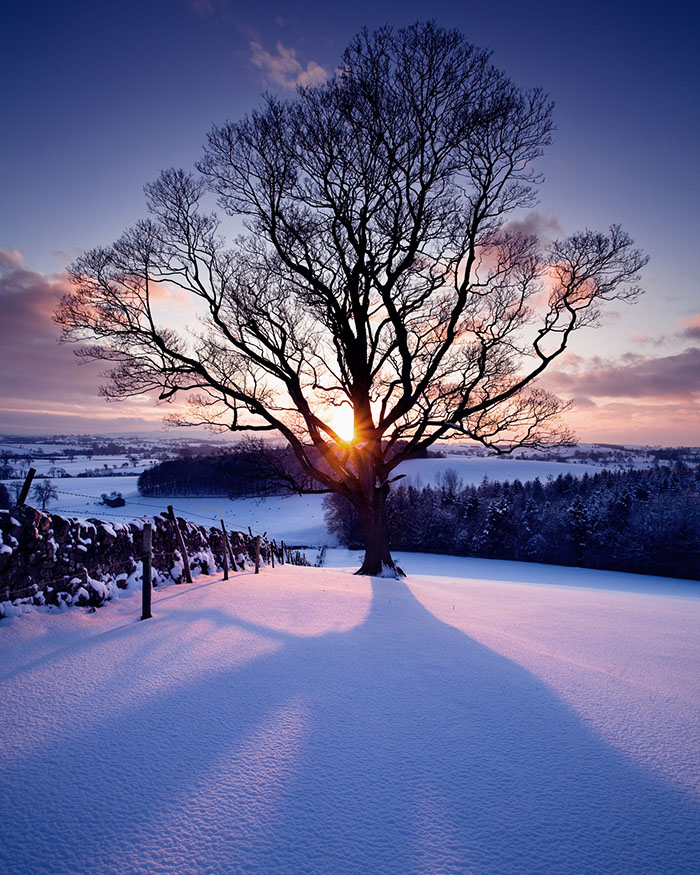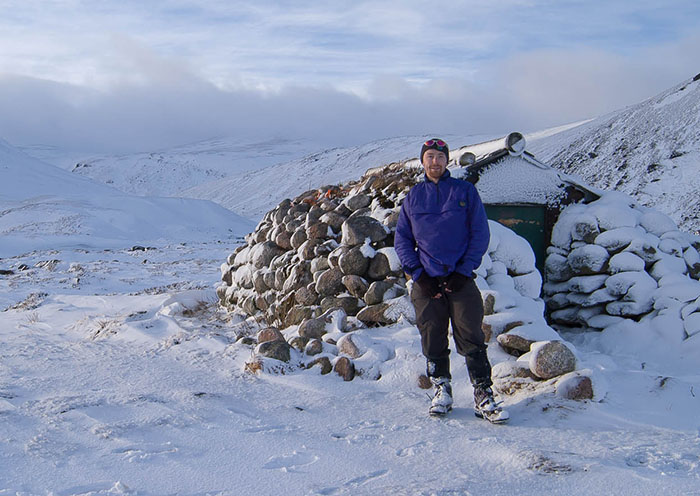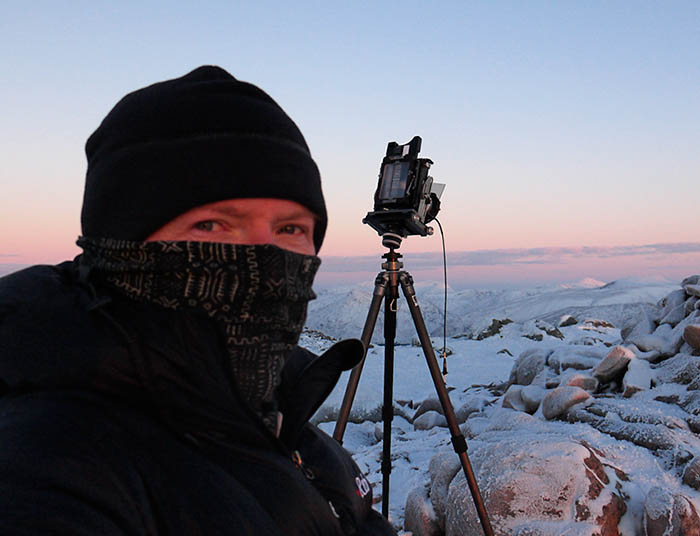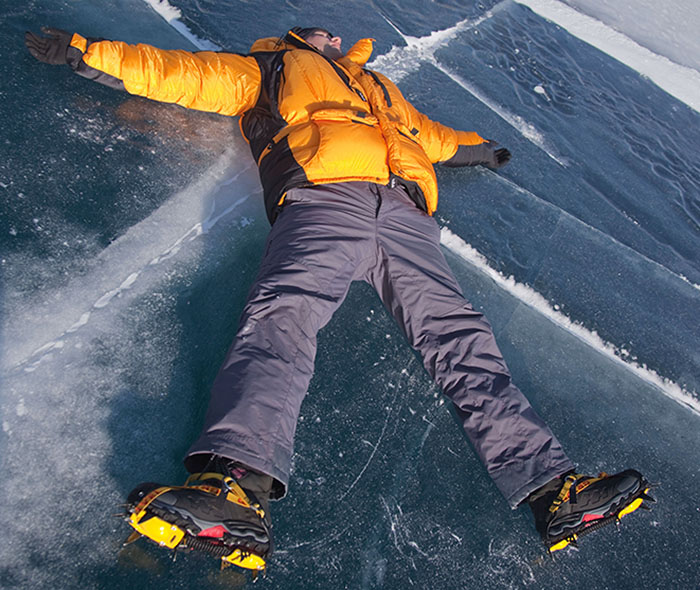Sound advice from eleven landscape photographers

Tim Parkin
Amateur Photographer who plays with big cameras and film when in between digital photographs.
It's been an exceptionally cold start to the year which I find deeply annoying because my supposed 'snowmobile' is out of action and being repaired after a blown headgasket that I suffered on the return trip from Cornwall a couple of weeks ago. Being as the main reason for buying the 4x4 version was to get out in these sorts of conditions, watching everybody else have fun while I'm stuck in has been particularly difficult. Anyway - I won't whinge (OK, just a little bit) and I've been putting the time I would have had in the field creating a location guide into researching how some of Britains top landscape photographers deal with the cold weather. The following are a compilation of notes made during phone calls, emails and general conversation made over the last week. We start with the man who has arguably been out photographing in Britains coldest ever weather - a minus 29 degrees in Moray last year.
Ian Cameron
Ian has been out in some of the coldest conditions that the UK has to offer (suffering from frostbite at one point when the temperatures hit -29 degrees). He has a pragamatic approach to cold weather gear and I had the chance to make a few notes whilst talking to him recently.
If it’s dry cold, then down jackets work very well, very light and assuming I’m not going up into the mountains. I try to use multiple layers, synthetic materials where possible (polartec for instance). The jackets I use have zips and so regulating temperature is as simple as unzipping the front. I keep the hood down typically as I get too hot quite quickly. A standard wooly hat pulled down over my ears if it gets really cold is fine and two pairs of gloves, a thin fingerless pair and a thick pair of mitts over the top.
I don’t typically use hiking boots as I don’t get on with gaiters and without them, you quickly end up with feet full of snow. I use a good pair of wellingtons (Hunter) with very thick neoprene inners (3-5mm) and these work really well with a single pair of good socks. My trousers are just standard walking trousers with a waterproof overtrouser when needed.
As for dealing with camera gear, film cameras are a lot better at dealing with the cold but even they have the odd problem when it gets really cold. Film can get brittle and can also suffer from electrostic discharge if the really cold air is very dry also, so I take care to wind the film on very slowly (otherwise you get pinprick spark lines on your photos). The electronics can get a little wierd if you breathe on the camera too much.
My tripod works very well in the cold (A Gitzo 3530LS) but I keep the bottom sections extended to stop snow getting packed into the locking mechanism.
See more of Ian's winter work here or have a good look around his whole website here.
Dav Thomas
Dav Thomas spends a lot of his time walking in the Peak District which sees more snow than most parts of the UK bar the Yorkshire Moors
Firstly I must say I'm not a 'climb up a mountain and bivy out on a precipice in -30 conditions' type photographer. Despite the fact that my girlfriend thinks I'm in mortal danger every time I leave the house with a tripod in my hand, I rarely travel more than a few miles away from the car, and generally return within 3 or 4 hours. Still, it can get to be pretty hardcore out there on those Peak District edges in the middle of winter so keeping warm is an important issue. It's not just a matter of comfort and safety either - the colder and wetter you get the more likely you are to skip that last, potentially brilliant shot in favour of a full English at the nearest café - keep warm and you're likely to stay out longer.
I admit that I am seduced by outdoor gear - I might even be accused of being a gear snob. I'm a big fan of buying decent stuff and hopefully not having to replace it every five minutes. I've got a fair amount of kit but I generally come back to a handful of items that I know are going to be comfortable that keep me warm. There are a few areas where I know I haven't found the perfect set up so in those areas, the search goes on.
Trousers
I have 3 main pairs of trousers and they get swapped about depending on the conditions. If I know rain is unlikely, or I know it's going to be light rain my first choice every time are my Craghopper Kiwi Winter Lined trousers. They have a fleece lining which keeps you pretty toasty are are reasonably hardy against rain showers. Being on the baggy side there's room underneath if it's really cold for thermals. Being cargo pantish they have a good few pockets to loose things in!
If I need something a bit more windproof and waterproof I have an excellent pair of Rohan Warm Goa trousers, these are a polyamide fabric and they are warmer than they look like they should be. Not entirely sure about the draw string around the waist but I guess it comes in handy after that full English Breakfast! It doesn't look like Rohan do them anymore but to be honest I've never had an issue with any Rohan gear so I'm sure their replacement will be just as good.
My 3rd pair of often used trousers are Rohan Superstriders - seriously good pants! They benefit of a built it gaiter which is great because I can never be bothered taking old school gaiters out with me. They have a brushed cotton liner to keep things warm and are wind resistant.
Top half
My approach up top is a thin base layer, some sort of fleece and a decent jacket - OK, so I'm not re-inventing the wheel but it works. Favourite base layer is my Rohan Core Zip long sleeve. It's not super tight which is a good feature in my book (although logic would suggest it doesn't wick as well), you don't really notice it's there which is good. Of course there are so many makes and styles of fast wicking base layer tops it's just a matter of finding a couple that suit you. I have got a merino wool top which is good but I don't find it as warm as a polyester top, that might just be the one I've got though. It is very comply against the skin though and they just don't get smelly!
Mid section - if I know it's going to be really cold out there I go for my trusty Lowe Alpine Aleutian stretch fleece top - a great top, very snug - I just wish it were a bit longer, it does tend to ride up over time. I have other mid level fleeces from North Face and Rohan which often get an outing.
Coat
Having tried a number of coats I always come back to my one favourite - a North Face Redpoint PrimaLoft . For me it's pretty ideal - not too bulky, warm but not silly warm like a full on insulated puffer jacket so it works well with layering and it has 3 good zip up pockets - I know some people like lots of pockets for their stuff but for me more pockets just mean more places to loose stuff. IT's water resistant and not too bulky. The only thing I'd change if I could is I'd give it a hood.
Feet
My tootsies are one where I haven't found the perfect set up. I do suffer from cold feet - they tend to itch like crazy when they get cold; not good. I have a good pair of Scarpa walking boots but warm they're not. I actually think my regular Caterpillar leather boots are warmer. I did invest in some heated socks last year but I managed to get the wrong size - the ones I ended up with would be ideal for sasquatch! I may have a go this year. I'd really love to give Columbia Bugathermo books a go with built in heaters - being a large format photographer I tend to spend a lot of time standing about in the same spot so some centrally heated footwear would be great!
Other bits
As someone whose hair days are pretty much over I have a large collection of beanie hats. I do find them to be a bit of a pain - they tend to get too hot so I normally find myself taking them off for a bit until my ears start to turn blue and then have another go. I guess there must be a good breathable beanie out there but I'm yet to find it.
Hand warmers - these are great things to carry, you can get them all over the place - they are smalls bags of liquid which, when activated start giving out a fair amount of heat - lovely for warming the hands when you've been fiddling about with the camera. they go hard after a few minutes, you re-activate them when back home by boiling in water for a few minutes.
Gloves - I've tried using a number of pairs of gloves - the fingerless style ones with a mitten like cover are OK but not super warm, I tend to go for a normal pair of walking gloves and take them off when using the camera - I can cope with the code for a few minutes. I do have a pair of North Face Etip Gloves on my Christmas list - hopefully allowing me to use the large format camera whilst still wearing gloves.
One other piece of clothing I like to wear is a North Face neck gaiter, an inexpensive bit of kit which really helps keep the warmth in and much less faff than a scarf.
You can see more of Dav Thomas' work here. Read Dav's other articles here.
David Ward
David leads photography tours and workshops all around the world including Iceland and Norway. I spoke to David on the phone and made a few notes - here are some summarised highlights.
Goretex has some serious problems and delaminates in heavy use (especially on the shoulders when using rucksacks). I’ve had two go .. just before the warranty run out annoyingly
I use a lot of Paramo gear because a lot of technologies stop working once you stop perspiring or when it gets wet (It needs heat and moisture vapour to work. Once wet and cold, it doesn’t work very well)
I don't wear a lot of gear - it has to be pretty cold in order for me to wear long johns... Lowe or Patagonia Capilene base layer (when freezing and below).
I use fingerless gloves (Thinsulate) and Jack Wolfskin mittens. The problem with Full on snow gloves is that they are a pain to take off and put on easily (they need to seal into your jacket sleeve). I have heard of people using silk gloves or even surgical gloves to allow fine control but stopping skin evaporation from chilling your fingers.
For trousers I wear Paramo Pajaro (which aren’t fully waterproof but wick well and dry quickly) over north face cargo pants. Boots are North Face Chilkats which have kept me warm in -19 degree conditions
Mid layers are Paramo Summit hoodie, top layer is an Aspira Smock and/or a Torres smock.The nice thing about the Aspira smock instead of the Pajaro/Halcon is that you can slip the waist belt of your ruck sack through the side waist slits so when you get hot you can open your jacket without taking your rucksack off.
See more of David's work here. Read David's other articles here.
Bruce Percy
Bruce spends a lot of time outdoor in the cold weather in Scotland but also in extreme cold in Patagonia and Iceland - He kindly sent me an email about his advice for staying warm as a landscape photographer
1. Don't go out!
2. Spade and sleeping bag in the car for safety. Preferably a down sleeping bag and some chocolate and mobile phone are important.
3. Goretex boots don't work. So many shops push them on folk, but you need leather boots, with sno-seal applied to keep the water out (slighly heat your leather boot in the oven and apply sno-seal which is absorbed by the leather).
4. Gaiters keep you really warm. They stop the wind rustling up your trouser legs, and stop any water coming over your boots too when you step into a boggy patch as is often the case
5. Gloves designed to help you operate your camera don't keep you warm, and they don't help you operate your camera either. So I now have the biggest, thickest cloves I can get. I take my hands out to operate the camera and put my hands back into the gloves once the camera is set up. My hands get warm very quickly in big thick gloves.
6. A hooded jacket to cover your head with a beanie hat on works for me, but I also use an Alpine-Lowe hat with sides that cover my ears. A hat must be capable of staying on your head and not flying off with the wind and rain.
7. Thermal layers and my trousers are fully waterproof. I don't like to have to wear trousers that need me to put an additional layer on, so I use trousers that are all in one items.
8. I like a jacket with one big pocket. I use the Paramo smocks because they allow me to put things in one place. I also have a whistle attached to the jacket in case I get into trouble
See more of Bruce's work here.
Joe Cornish
Joe was down in London on business but I managed to get a few minutes to chat about his approach to the cold. These are taken from my notes so are not direct quotes.
I tend to get quite cold (probably my age) so as soon as it get down to freezing I use leggings of various brands, Lowe Alpine, North Face, etc. I never use cotton though.
Really Good socks are important and I sometimes wear two pairs, definitely so with wellingtons.
Long sleeve thermals with crew necks are reall useful with Patagonia being a good brand and Paramo being brilliant - Some people still use Helle Hanson but they didn’t get the nickname “smelly hellys” for nothing.
My personal most important item is a pair of really good boots. I use La Sportiva mountaineering boots (possibly Nepal ones? - tim) which work really well in thick snow. They are expensive but are really worth the money. Generally I use wellingtons which are OK but don’t keep you warm when temperatures plummet.. if you’re doing serious time/distance in the snow you need decent boots. I would hesitate to recommend some of the high street brands, stick to good European specialist brands such as La Sportiva, Scarpa, etc. If you do a lot of time in the mountains, make sure they take crampons/snow shoes. Duck type insulated boots are a good alternative but maybe not good for long walking/climbing.
Paramo mountain shirt or pull-on are excellent for wicking and thermal properties - you really need to keep a technical continuity through your layers. I also use fleece or mountain shirt fleece layers, mostly Paramo again.
For dry snow, Paramo Cascada are great but I use Aspira Salopettes otherwise which are fully waterproof (but heavy and can get warm). If you think skiing gear you won’t go too far wrong. Torres insulated overtrousers amazing - single most important piece of extra insulation I have, will keep you going for a long time in cold conditions.
Finally, I use Paramo Shells; in the high mountain it is Aspira shell but for general photography, the Halcon/Pajaro are very good. But for really cold conditions, the Torres smock is almost essential. (for less bulky option, torres sleeves work very well).
The best solution is probably fingerless base gloves with a good insulated overglove (or mitten). Finally, a good buff is a great idea to keep out the cold winds. Hyperthermia is the biggest danger and it is very difficult to tell the symptoms, it’s probably a good idea to read up how to recognise if you, or others, are succombing to it.
See more of Joe's work here. Read Joe's other articles here.
Jason Theaker
Jason was busy at work but he has sent me an email with his advice for working in the snow/cold conditions.
Camera technique
- I use disposable tissue wipes, as my usual microfiber lens cloths don’t work...
- Extend bottom legs of the tripod first into the snow, combats frozen mechanisms.
- Use my hat for camera when it snows...
- Cable release, with end in my pocket to keep hands warm.
- Make sure I only hold the tripod on the rubber insulation.
- Gardening mat or knee pads for frozen ground help when doing low angle stuff
General stuff
- Be mindful of where you step (walk around edge of field, don’t just walk around in the snow).
- Get out early in frost, it won’t last long and works real well with early light
- Weather (and cold are the main issues) :
- Dress in waterproof gear
- I use walking boots with gaiters (wellies don’t keep your feet walk)
- Fingerless gloves (my own design)
- Waterproof leggings
- Flask
- Shovel and old rope in the car, (friend to push you out is handy, de-icer also)
See more of Jason's work here.
Mike McFarlane
Mike has some great experience of winter working and has also worked in a mountaineering garment shop
I come from a Scottish winter climbing background where the standard clothing is pile/pertex garments made by Buffalo or Montane. The windproof outer shell keeps the wind out and the pile fleece inside keeps me well insulated. Most of these garments feature lots of ventilation zips so I can control my body temperature very well to prevent sweating too much, and then zip everything up to keep cosy when I stop to photograph. I've found nothing that even comes close to the performance in our cold damp winters, especially given the low price compared to many newer solutions. They also last for years, my first one did about 15 years of hard winter climbing and mountain biking.
Ideally pile/pertex should be worn next to skin, with the fit as close as possible. They tend to be quite ill fitting, so it is worth trying a few sizes and styles from different brands. I wear a cheap waterproof over the top for wet sleet days. For really cold conditions, below about -10degC, the pile/pertex salopettes are amazing, but can be too warm. I’ve been on the north face of Ben Nevis in the jacket and salopettes with temperatures of about -20degC and been too warm when walking! Cosy, comforting and amazing value for money.
Mike is writing a full length article on cold weather clothing and as someone who has worked in a mountain clothing shop and spent a lot of time outdoors, it should make a very good read! I've been told it should be online in the next week or so here. In the meantime, check out more of Mike's work here.
Richard Childs
Richard is a full time professional photographer living in Oban who spends a lot of time on the hills - he regularly works in 'difficult' conditions and doesn't let the weather stop him from getting the picture
As Winter arrives I usually spend some time, and a little money fine tuning my outdoor wear based on a previous years experience. There's no doubt that being comfortable will lead to a more enjoyable and probably successful time on the hill. Roald Amundsen was credited with saying 'there's no such thing as bad weather, only inappropriate clothing' and every miserable day I can remember on the hill was down to this. While we can arm ourselves against much of what Britain's maritime climate throws at us spending increasing time in the mountains as I do means paying a little more attention to detail to avoid disappointment, misery and even disaster. Simply loosing a glove has in the past lead to the demise of more than one climber here in Scotland. We all carry spare bits and pieces for our cameras but often neglect ourselves in doing so.
Because I carry a heavy load I try to keep my clothing light, layering to provide the warmth, and regularly changing the number of layers as I go to keep me comfortable. Unfortunately, I sweat alot with sustained exertion so I now take spare base layers and change into these on arrival at my destination to ensure that the clothes next to my skin are dry and do not wick away my body heat. This does mean stripping off on a mountain top in sub-zero temperatures but this is far more desirable than standing around in wet clothes for hours. Those of you who know me well enough also know of my reputation for this anyway!
I'm not one of those people who kits myself out in one particular brand. I try to find what really works for me and then stick with it through the years until the 'new and improved' version comes out and proves to be the opposite.
I currently use combinations of the following:
- Lowe Alpine breathable base layers
- Merino Wool Base layers ( top and bottom) but not when ascending.
- Mid layer fleeces by The North Face and Patagonia
- Reversable tops by Paramo.
- Trekking Pants by The North Face and Crag Hoppers.
- Fleeces by Sprayway and Vaude
- Paramo Torres Smock
- Paramo Fuera Fleece/Windproof combination
- Rab Down Jacket
- The North Face Caber Hybrid Pants ( possible the best bit of outdoor wear I have ever bought)
- Scarpa SL and Manta boots
- Grivel Crampons.
- Gloves and mittens
Finally, a Buff. This simple tube of fabric provides me with a hat, balaclava, midge net, neck warmer and lens cleaning cloth, all for about £12, a genuine bargain.
See more of Richard's work here. Read Richard's other articles here.
Rob Hudson
Rob has hiked for most of his life prior to being a photographer and likes to keep things simple. I love the picture has above too - really shows a heavy snowstorm well.
OK, first point to make is you wont find a list of expensive / fashionable outdoors gear in my wardrobe, I came to landscape photography after a lifetime of walking and hiking, since I was a small child. There really isn't any point in wearing half the mountaineering shop, like most people seem to (even in the middle of summer!), for 95% of my experience a few appropriate and well chosen items will do. A little bit of cold and wet rarely does you any harm!
From the bottom up....
The trick is to choose appropriately to the conditions and layer.
Base layers, unless I'm planning extreme winter mountaineering, I just don't bother with the "wickable" polyester based base layers. I find they get so hot under physical exertion, that it makes it very difficult to control body temperature - and that is as important as anything. An ordinary cotton tee shirt is just fine for me, so what if it gets a little damp, that's how your body naturally regulates temperature.
I much prefer to layer appropriately, wear things with zips that are easy to undo or remove / add as required.
Next up in winter I usually wear a microfleece top, my fave is from Rohan which is tight fighting, warm and extremely light.
If it's getting colder I wear a 300gm fleece or in extreme cold I actually prefer an ordinary high street cardigan, it's 80% acrylic and 20% wool, wicks beautifully and is about the warmest thing I own. Plus the zip means I can regulate body temperature as required.
Trousers wide I have a wide variety to choose from. In late spring and early autumn it's a light weight pair of Rohan hiking trousers. Later in the seasons (or for milder days) I have a pair of heavier weight Craghoppers and in extreme winter a pair of lined Craghoppers. Both the later are a couple of sizes too big, so I can wear fleece long-johns if it's really mean out, but honestly unless I'm doing star trails up a mountain in the middle of winter I wouldn't bother.
Boots are a fairly expensive pair of Swiss made Raichle "Motion Control" which are leather outer and Goretex lined. Long experience has taught me that cheap boots just don't last. They're pretty much all year boots (unless it's hiking sandals weather), waterproof, comfortable, warm enough for winter use and with a sharp enough edge on the Vibram soles
to get some traction in snow. I also have a range of socks, for winter a pair with merino wool for added warm. I very rarely get cold feet in that combo.
Coats are a choice between a pretty basic Berghaus waterproof, nothing special, has their own proprietary breathable waterproof membrane, lots of pockets. Again it's a couple of sizes too large so I can get all the layers needed underneath. Or an ancient 1980s Line7 winter mountaineering jacket (Goretex outer, Thinsulate lined) which only comes out about 3 times a year and will therefore never wear out. It's claimed to be suitable for up to minus twenty, but I doubt that's true, having warn it in far less for star trailing last year and been pretty cold.
Lastly Goretex Berghaus waterproof over trousers and Berghaus Gortex knee high gaters, neither of which get warn as a rule. Hats are a Thinsulate woolly number and a couple of pairs or Thinsulate gloves, but I normally only use them for carrying a cold tripod,I'm not really a hat or gloves person. I was quite surprised to find my hair frozen last week after taking my hat off during a steep climb, but still I wasn't cold, the exertion kept me warm.
So general advice is you don't need to spend a fortune on the most expensive gear in the shop (that's for mountaineers or people who are scared of the outdoors) layer and remember to pack a spare fleece for when you're standing still with the camera or when required.
See more of Rob's work here. Read Rob's other articles here.
Adam Pierzchala
Winter woollies? Hmm, a tricky one this, lots ifs and buts...
Seriously, there are many factors at play: what your activity will be, how
cold/wet it is, how well you as a person withstand weather etc.
In summary, here is what I wear for really cold winter photography i.e. lots of standing around but probably not very much heat-generating trekking to get to the location.
Upper body (layering): Long sleeve Paramo base T-shirt, North Face standard thin fleece, Paramo "Explorer" pull-on, Paramo Taiga fleece, North Face Gore-tex windproof.
Total 5 layers with increasing warmth and a final windproof (and rainproof) outer jacket. This combination kept me warm when we were on a dawn shoot at the Grand Tetons at -9.2C. If it's maybe between 0 and -5 C and not very windy (as in Yellowstone), then I would dispense with the Explorer layer and might even swap the GoreTex for my much lighter Paramo Fuera jacket.
Legs: Craighoppers Kiwi lined trousers.
Feet: Just normal mountain boots with walking/trekking socks. I would appreciate proper lined winter boots when it is really cold, but don't go out in such conditions often enough to justify the cost.
Head: Thinsulate soft hat that I pull down over the ears. If it is also windy and/or raining then I use the hood attached to my jacket. And a tube-scarf for the neck - these are thin so not cumbersome but really great.
Now for the anecdote: I used to be a traditionalist and had a heavy double cotton windcheater with a woolly jumper underneath. Then I moved to GoreTex and that's very good,
but a bit sticky in milder weather. More recently I was persuaded to try Paramo (those blasted L&L endorsements...) and tried their base layer (reversible T-shirts). These are superb and just last summer in the Pyrenees I was wearing one such T-shirt while running downhill at around 2000-1500 metres through a cloud away from a thunderstorm. Not only did I stay warm but despite the cloud vapour itself (I got a super photo of dew laden grass!!) I felt amazingly dry. Daft I know, but really I did.
I have a Paramo Taiga fleece and Fuera windproof and like them both for cold but not bitterly cold low temperatures. Used them in the Californian Sierra on an L&L tour a couple of years ago and basically they were fine. I am not convinced that these would keep me as warm as my old cotton windcheater and woolly jumper would have done when standing around. But, they keep the wind and rain off, so can't be bad. But Paramo is great for activity wear for example for the approach to a remote location and of course when
climbing/descending. I suppose that this is where layers come in so you can add a layer when you get to your spot and reduce your activity level. If I had oodles of cash and was sure to use the jacket on many many days in a year, then perhaps Paramo's top of the range £300 Halcon jacket is the thing to buy.
See more of Adam's work here. Read Adam's other articles here.
David Clapp
David gets about a bit, as they say, and for such a warm guy, he certainly knows how to deal with the cold (OK - I'm trying too hard). Anyway - he sent me an email discussing his 'tactics'
See more of David's work here. Read other articles by David Clapp here.

